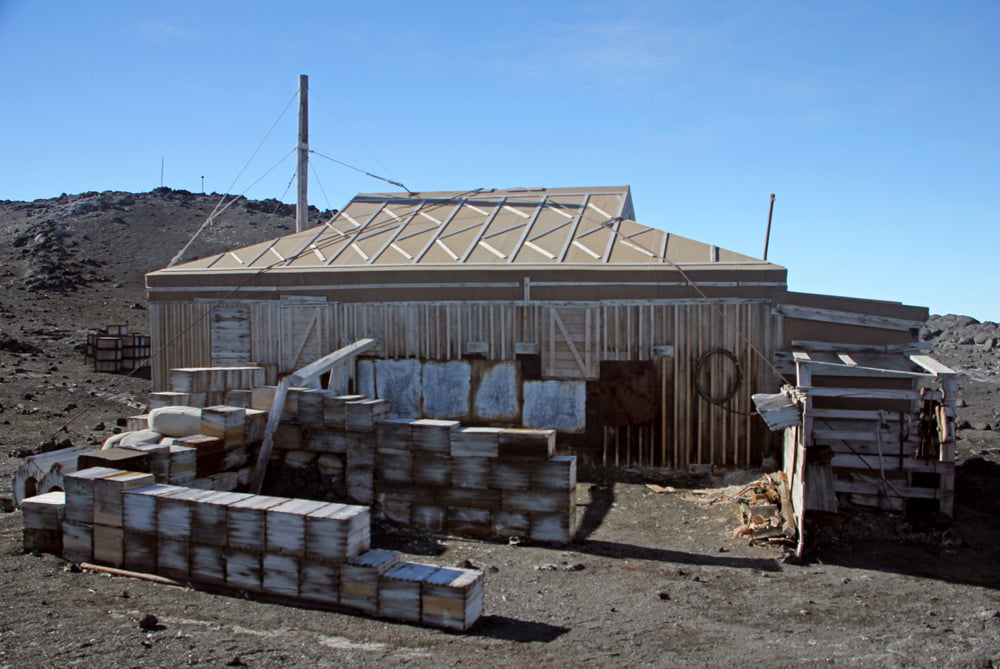When you think of Antarctica, you think of ice and penguins. But the Earth’s southernmost continent has more to offer. For example, one of the eeriest and creepiest places in the world. This is the story of the Shackleton’s hut, build by housed explorer Ernest Shackleton and his crew.
Ernest and his crew were on an expedition from 1907 to 1909. Visitors today say claim they have seen Shackleton’s ghost walking towards them as they step inside.
Listed as one of the world’s most endangered sites, the Hut remains one of the few buildings from the last century still standing in Antarctica.
History of the Expedition
The Nimrod expedition was the third British Expedition to the Ross Sea region within 10 years. Shackleton had a shore party of 14 men, a specially designed prefabricated hut, 15 Manchurian ponies, nine dogs, and an air-cooled, four-cylinder 11kW motorcar.
Shackleton and his men achieved a lot of firsts during their expedition. For example, in March 1908, five of his men were the first to climb Mt Erebus.Then, in late 1908, Shackleton led a party of four in an attempt to be the first to reach the Geographic South Pole. They went on a man-hauling journey for two and a half months. They came less than 97 nautical miles from the pole when Ernest made a decision to turn for home.
Shackelton’s whisky
In January 2010, a conservator found five crates encased in ice under Shackleton’s Antarctic base. Three of them contained Mackinlay’s whisky and two contained brandy. The three whisky crates were excavated and then one of them was sent to New Zealand.
Researchers found 11 bottles of the 114-year old whisky, still sheathed in their paper and straw packaging. Even the then-owner of Whyte & Mackay flew to New Zealand to see the extraordinary find. He transported three bottles to Scotland on his private jet for scientific analysis.
In what was considered a unique opportunity for the whisky world, he and his scientists subjected the bottles to sensory and chemical analysis. They wanted to establish the flavor and composition of a product manufactured more than a century ago.
In April 2011, the company and its master blender successfully recreated an exact replica of the old whisky, giving birth to Mackinlay’s Rare Old Highland Malt Whisky. The popular whisky got a second edition one year later, The Journey.
Sales from both editions have gone as donation to the Trust’s conservation work in Antarctica. National Geographic even made a documentary about the whisky’s journey from obscurity to world-wide attention.
What is inside?
When he got to Antarctica, Shackleton and his men built the hut as robust as possible. And they had to so they can use it as refuge from the extreme conditions for 14 months. The main part of the hut is still standing today. This is just testament to the efforts and skills of Shackleton and his designers.
It is basically a timber structure prefabricated by Humphreys Limited of Knightsbridge in London in 1907. First assembled in London, and then the parts were marked for re-erection on site.
Today, it is listed as one of the most endangered sites in the world. Inside you can find artifacts like tinned food, scientific instruments, and a stove still standing.
The inside is shelved with provisions from Edwardian-era, serving as a memory, reminder, and testament of the era. There are tinned meats and vegetables, bottles of raspberries and gooseberries, red currants wrapped in straw, and much more.
![]()
The interior is a museum of itself, fully equipped with original furniture and cooking stove. You can even see the jackets and laundry of Shackleton and his crew hanging on hooks.
The Many restoration projects
The hut has been subject of extensive restorations. The history of the hut is extraordinary as well. Members of the Terra Nova Expedition, visiting the site in 1911 found years-old evidence of rapid departure, like a meal left on the table uneaten.
When US icebreaker Edisto arrived in January 1948, boards were missing from the roof. The stables were full of snow, and the garage had collapsed.
So, in 1957 and 1958, a crew from New Zealand Navy Ship HMNZS carried out cleaning duties around the hut. And then, in 1959, a restoration committee was established by the government of New Zealand. They decided to restore the hut to its original state, ensuring all artifacts of value to be preserved.
![]()
The work on restoring the cooking area, biological laboratory, and stable, was carried out from 1960 to 1961.
By the 1990s, the Antarctic Heritage Trust installed a data logger to monitor temperature and humidity at the hut. From 2004 to 2008, international team of heritage and conservation specialists spent the summer securing the hut for future generations. They made the building structurally secure and catalogued more than 6,000 artifacts.
Today, the site is listed by the Antarctic Treaty System as an Antarctic Specially Protected Area.




















